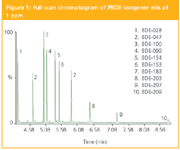Analysis of Polybrominated Diphenyl Ethers Using the Clarus 500 GC–MS
The Application Notebook
This application note will demonstrate a GC–MS analysis of common polybrominated diphenyl ether (PBDE) congeners. An optimized method will allow the Clarus GC–MS to provide ample separation and high yields of all PBDE congeners. The extended mass range of the Clarus 500 MS and high-mass calibration will produce mass spectra with very high levels of accuracy.
Polybrominated diphenyl ethers (PBDEs) — commonly used flame retardants — are under scrutiny, as a result of their global presence and rapid bioaccumulation. Recently, legislative and commercial groups have initiated programmes to reduce or eliminate specific PBDE congeners because of their potential health threat.

Figure 1
Experimental
GC–MS analysis of PBDEs presents a wide range of challenges. PBDEs are unstable at high temperatures and will rapidly degrade under inappropriate GC conditions. Resulting from their low vapour pressure and high boiling point, a temperature programmed splitless injection must be used to minimize sample contact with metal surfaces in the injector port. Retention time is a critical parameter and must be minimized to avoid degradation. As a result, a short column with a thin stationary phase is optimal. For this application, a 15 M × 0.25 mm i.d. × 0.1 μm film Elite-5ht column was used.
High molecular-weight detection by GC–MS requires a non-traditional calibration technique. The ions of the standard calibration gas PFTBA (FC-43, Heptacosa) are limited to mass-calibration fragments up to 614 u. The mass range of the Clarus 500 MS is 2–1200 u. To achieve accurate mass calibration in the upper half of this mass range (600–1200 u), it is necessary to use an alternate mass-calibration standard with known ions above 600 u. This technique uses a GC injection of the Triazine calibration standard, which produces ions up to 1185 u.
Along with GC optimization and high-mass calibration, the data-acquisition functions of the mass spectrometer must be optimized to achieve maximum sensitivity, while collecting sufficient scans across each peak. Different combinations of SIR and scan functions are used to achieve necessary sensitivity.
Results
As demonstrated here, the PerkinElmer Clarus 500 GC–MS provided excellent accuracy, precision and sensitivity in the analysis of PBDE congeners. Ten PBDE congeners were calibrated and optimized. Sensitivity, linearity and stability were checked. A linear calibration range of 10–1000 ppb (50–5000 ppb for Octa- and Deca-BDE) was chosen, as a result of industry requests. Within this range, the curve for Deca-BDE, one of the most challenging flame retardants, demonstrated a linearity of R2 = 0.994. The stability was verified and over 20 Deca-BDE injections had a percent standard deviation for the peak area of 9.6%, showing that the area is extremely reproducible.
Conclusion
The successful use of this application will allow analysis of many PBDE congeners by GC–MS. Method optimization demonstrated run times of less than 10 min, allowing for high throughput. Combining a short run time with system stability and required sensitivity allows for a complete application solution for PBDE analysis.

PerkinElmer Life and Analytical Sciences
710 Bridgeport Avenue, Shelton, Connecticut 06484, USA
tel. +1 800 762 4000
fax +1 203 944 4904
website: www.perkinelmer.com
New Method Explored for the Detection of CECs in Crops Irrigated with Contaminated Water
April 30th 2025This new study presents a validated QuEChERS–LC-MS/MS method for detecting eight persistent, mobile, and toxic substances in escarole, tomatoes, and tomato leaves irrigated with contaminated water.
University of Tasmania Researchers Explore Haloacetic Acid Determiniation in Water with capLC–MS
April 29th 2025Haloacetic acid detection has become important when analyzing drinking and swimming pool water. University of Tasmania researchers have begun applying capillary liquid chromatography as a means of detecting these substances.

.png&w=3840&q=75)

.png&w=3840&q=75)



.png&w=3840&q=75)



.png&w=3840&q=75)






